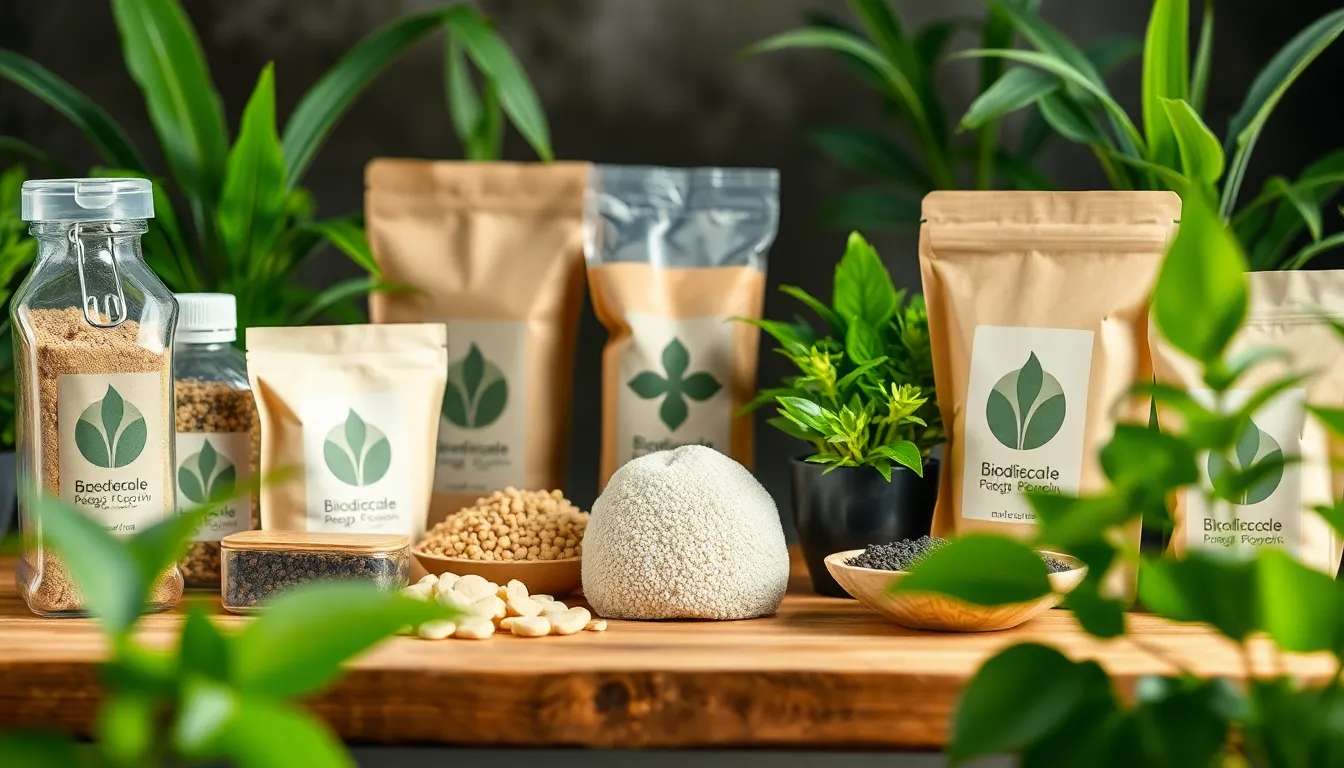In a world where plastic seems to be the reigning champion of convenience, sustainable packaging technology is stepping into the ring like a superhero in eco-friendly spandex. It’s not just about looking good; it’s about saving the planet one biodegradable box at a time. Imagine unwrapping your favorite snacks without the guilt of contributing to a landfill the size of Texas. Now that’s a win-win!
As consumers become more eco-conscious, businesses are scrambling to keep up, and innovation is booming. From plant-based materials to reusable designs, the packaging industry is undergoing a transformation that’s both impressive and necessary. So, buckle up as we dive into the quirky yet crucial world of sustainable packaging technology, where every wrapper tells a story and every box has a purpose.
Table of Contents
ToggleOverview of Sustainable Packaging Technology
Sustainable packaging technology addresses environmental challenges stemming from traditional packaging materials. Biodegradable options, derived from natural sources, replace conventional plastics, breaking down more easily in composting environments. Reusable designs, such as containers meant for multiple uses, minimize waste generation and encourage consumer participation in recycling efforts.
Innovative materials like plant-based plastics and mushroom-based foams gain traction in the packaging industry. These alternatives not only reduce reliance on fossil fuels but also create less carbon emissions during production. The development of water-soluble films presents another sustainable option, showcasing versatility across various applications.
Consumer demand significantly influences the shift towards these eco-friendly solutions. Research indicates that approximately 70% of consumers express a preference for brands that prioritize sustainable practices. Companies, in response, adopt sustainable packaging technologies to enhance brand loyalty while contributing positively to the environment.
Regulation also plays a crucial role. Governments and organizations worldwide implement policies to reduce plastic waste, prompting industries to adapt swiftly. By investing in sustainable packaging technology, businesses position themselves at the forefront of market trends and environmental responsibility.
Collaboration among stakeholders fosters the advancement of sustainable packaging innovations. Manufacturers, retailers, and consumers share responsibility for reducing environmental impact through the adoption of smarter packaging solutions. Continuous improvement and research drive the next generation of sustainable materials, making significant strides toward a greener future.
Benefits of Sustainable Packaging Technology

Sustainable packaging technology offers numerous advantages that contribute to environmental and economic well-being. Emphasizing eco-friendly practices leads to substantial benefits.
Environmental Impact
Reducing plastic waste stands as a primary environmental benefit of sustainable packaging technology. Innovative materials decompose more easily, lessening landfill contributions. For instance, biodegradable options like plant-based plastics break down naturally, reducing environmental pollution. Choosing reusable designs minimizes single-use items, slowing down resource depletion. Research supports that about 70% of consumers favor brands demonstrating eco-conscious efforts, highlighting the importance of sustainability in the marketplace. Decreasing reliance on fossil fuels during production lowers carbon emissions, reflecting a commitment to combating climate change and protecting biodiversity.
Economic Advantages
Cost-saving opportunities arise with sustainable packaging. Employing biodegradable materials often leads to reduced waste disposal expenses, benefiting companies by lowering operational costs. Companies adopting eco-friendly designs can enhance brand loyalty, driving increased sales. Approximately 70% of consumers prefer supporting brands dedicated to sustainable practices. This preference encourages businesses to adopt innovative technologies to remain competitive. Economic incentives may also arise from regulations favoring sustainable initiatives, with governments worldwide pushing for greener policies. Collaborating with other stakeholders fosters innovation, leading to new market opportunities while establishing a responsible brand image.
Types of Sustainable Packaging Solutions
Sustainable packaging solutions encompass a variety of options designed to minimize environmental impact. Each type plays a significant role in the move away from traditional materials.
Biodegradable Materials
Biodegradable materials naturally break down over time, significantly reducing landfill waste. Options include plant-based plastics made from renewable resources like cornstarch or sugarcane. These alternatives decompose in various environmental conditions, lessening pollution. They offer similar durability and usability as conventional plastics while promoting sustainability. Research indicates that around 70% of consumers prefer products packaged in biodegradable materials, highlighting market demand for these solutions.
Recyclable Packaging Options
Recyclable packaging options enable consumers to repurpose materials instead of discarding them. Common materials like cardboard, glass, and certain plastics can be transformed into new products through recycling processes. Incorporating clear recycling instructions on packaging enhances consumer participation, leading to greater recycling rates. Companies adopting these methods benefit economically by reducing reliance on virgin materials. Government regulations increasingly encourage the use of recyclable materials, stimulating industry adaptation and sustainability efforts.
Innovative Technologies
Innovative technologies drive the creation of cutting-edge sustainable packaging solutions. Notable advancements include water-soluble films that dissolve in water, reducing waste and reliance on landfills. Another example is mushroom-based foams, which provide compostable cushioning without fossil fuels. These technologies not only enhance package functionality but also align with consumer preferences for environmentally friendly options. Companies investing in innovative materials position themselves favorably in a competitive market, attracting eco-conscious consumers.
Challenges in Implementing Sustainable Packaging
Sustainable packaging technology faces various challenges that hinder its widespread adoption in the industry.
Cost Implications
Cost remains a significant barrier for many companies transitioning to sustainable packaging. Implementing eco-friendly materials often incurs higher production expenses compared to traditional options. Manufacturers may struggle with increased costs related to sourcing sustainable materials or adopting new technologies. For instance, biodegradable plastics can be more expensive, impacting profit margins. Despite the initial investment, some companies overlook potential long-term savings that stem from reduced waste disposal costs.
Consumer Awareness
Consumer awareness also plays a crucial role in the adoption of sustainable packaging. While approximately 70% of consumers express a preference for sustainable brands, many might lack sufficient knowledge about the benefits of eco-friendly options. Educating consumers about recycling and proper disposal remains necessary to enhance participation in sustainability efforts. Brands experience challenges in conveying their packaging initiatives effectively, as clear communication can influence purchasing decisions. Building awareness and understanding among consumers drives demand for sustainable practices, supporting long-term industry transformation.
Future Trends in Sustainable Packaging Technology
Emerging technologies play a key role in shaping sustainable packaging solutions. Bio-based materials, such as those derived from agricultural waste, are expected to gain wider adoption, reducing reliance on fossil fuels. Innovations like compostable films will likely continue evolving, enhancing their applicability across various industries.
Growing consumer awareness drives demand for transparency in packaging materials. About 75% of consumers seek clear labeling that identifies sustainable options. Brands that effectively communicate their environmental efforts can boost customer loyalty.
Regulatory changes are becoming more stringent. Governments worldwide are setting ambitious targets to phase out single-use plastics, encouraging industries to innovate rapidly. Compliance with evolving legislation urges companies to prioritize sustainable practices in their operations.
Collaboration among stakeholders remains crucial for advancing sustainable packaging practices. Manufacturers, retailers, and consumers must work together to optimize the lifecycle of packaging solutions. Engaging consumers through education initiatives fosters awareness and responsibility for proper disposal and recycling.
Advancements in smart packaging technologies are also emerging. These technologies can provide real-time data on product freshness, reducing food waste. Integration of IoT (Internet of Things) in packaging offers opportunities for further innovation, enhancing supply chain efficiency.
Investments in research and development will drive the future of sustainable materials. Companies prioritizing cutting-edge innovations stand to maintain a competitive edge. As competitive markets evolve, businesses championing sustainability can differentiate themselves and attract eco-conscious consumers.
Overall, the landscape of sustainable packaging technology will continue shifting. A focus on adaptability and innovation is vital for addressing environmental challenges. These trends collectively contribute to a more sustainable future, emphasizing the importance of collective action across various sectors.
Sustainable packaging technology is poised to reshape the future of the packaging industry. As companies innovate and adapt to consumer preferences, the shift towards eco-friendly solutions is becoming increasingly vital. The collaboration among manufacturers retailers and consumers is essential for driving this change.
Investments in biodegradable materials and reusable designs not only address environmental concerns but also enhance brand loyalty. With growing regulatory pressures and consumer demand for transparency the momentum behind sustainable packaging will only strengthen.
By embracing these advancements the industry can significantly reduce its environmental footprint while paving the way for a greener more sustainable future. The journey towards sustainable packaging is just beginning and its impact will resonate for generations to come.
